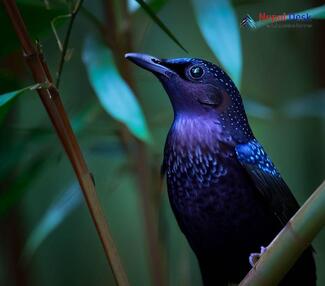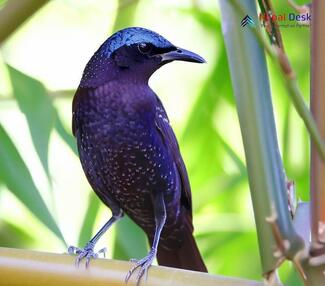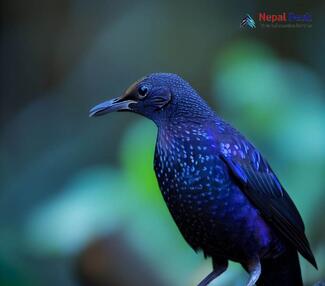Nepal boasts an astonishing variety of bird species, and while you're wandering through this gorgeous country, you absolutely can't miss the magical Blue Whistling Thrush. You can find this captivating bird all across Nepal, and its melodious tune will undoubtedly etch itself into your heart. Adorned in stunning shades of dark blue and shimmering feathers, the Blue Whistling Thrush (Myophonus caeruleus) is truly a spectacle to witness. But its mesmerizing colors aren't the only thing that sets this bird apart; with a unique high-pitched whistle, it creates a harmony that will leave both birdwatchers and nature lovers totally spellbound.
A Captivating Sight
The Blue Whistling Thrush is a truly eye-catching bird, setting it apart from other feathered friends. This medium-sized beauty, with a length of around 33 cm, is adorned in vibrant blue plumage with hints of violet and shiny spots on its wings and tail. Combine that with its powerful beak and dark eyes, and you have a visual feast for bird enthusiasts.
Nature's Melodious Orchestra
Renowned for its tuneful calls, the Blue Whistling Thrush's name reflects the whistle-like quality of its song. As a skilled mimic of surrounding sounds, this bird creates an audible masterpiece in the wild. Its enchanting melodies are best heard from dawn until dusk, making it a special treat for early birds exploring Nepal's lush green forests.
An Ideal Home for the Thrush
Nepal's diverse natural attractions provide an excellent habitat for the Blue Whistling Thrush. These birds favor areas with rich vegetation near water sources. They can often be found in thick forests close to cascading waterfalls or tranquil rivers, even at heights of up to 3,800 meters! National parks like Langtang National Park and Shivapuri Nagarjun National Park are top spots to see them.
Feeding Practices and Personality Traits
As an omnivore, the Blue Whistling Thrush appreciates a varied diet featuring insects, fruits, and occasionally small animals such as lizards or frogs. These remarkable beings display both confidence and caution: they'll bravely venture near human settlements in search of food while always being vigilant of potential dangers.
Caring for Their Future
Although the Blue Whistling Thrush isn't endangered or threatened, it's crucial to prioritize preserving and conserving their natural habitats in Nepal. This way, these delightful songbirds can continue thriving and delighting all who cherish the wonders of nature.
Journey to Nepal and immerse yourself in its verdant forests. With a bit of luck, you might encounter the Blue Whistling Thrush and be serenaded by their thrilling melodies – a sound you'll never forget during your time in this amazing country.
Where to Spot Them in Nepal
These captivating birds can be found in various locations across Nepal. They usually inhabit subtropical or tropical moist montane forests that offer ample food supplies and nesting spaces. Prime birdwatching areas include Shivapuri Nagarjun National Park near Kathmandu Valley, Chitwan National Park, and Langtang National Park. Visit these incredible destinations during migration seasons, and keep an eye out for these exquisite creatures!
What to Watch For
The Blue Whistling Thrush exhibits intriguing habits and behaviors that make observing them utterly worthwhile. They tend to be more active during dawn and dusk, so plan your birdwatching adventures accordingly. Often found alone or in pairs, they forage for their favorite foods like insects, snails, and fruits.
Intriguing Tidbits About the Blue Whistling Thrush
- The Blue Whistling Thrush has a special talent for mimicking other birds' calls as well as some non-avian sounds.
- They're quite territorial; you might see them warding off other animals or birds that approach their nesting areas.
- Female Blue Whistling Thrushes are in charge of nest-building duties, crafting nests from plant materials like roots, leaves, moss, and twigs. These nests are typically situated on ledges or tree cavities.




